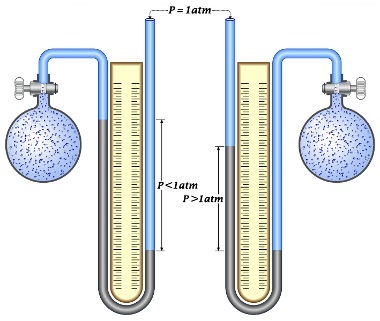O pressure gauge is an equipment used to measure the atmospheric pressure and the pressure of gases and liquids. The applications of this equipment are diverse, and it can be used to measure pressure in industrial and pneumatic machines, blood pressure etc.
There is also the possibility of using this instrument to determine the velocity of a moving fluid from the equation of Bernoulli. We know that, in the region where a fluid moves, there is a decrease in pressure. Thus, knowing the pressure difference generated by the passage of wind, for example, we can determine its speed.
The simplest kind of pressure gauge is the one of Mercury. In this equipment, the liquid metal is placed in a U-shaped container with one end in a contact with the material that will have the pressure gauged, and the other end is in contact with atmospheric pressure.
The difference in pressure between the ends generates a difference in the height of the mercury column. This height difference is used to determine the desired pressure through the stevin's law.

The height difference of the liquid column provides the determination of the gas pressure
Bourdon Manometer
The Bourdon Manometer was created by Eugene Bourdon in 1849 in France. In this equipment, there is a closed metal tube that is spirally wound at one end. The free end is placed in contact with the material for which the pressure value is to be found.
By modifying the pressure value inside the tube, the spiral metal tends to unwind and move a pointer that indicates the pressure values. This equipment is the most used in the industry for measuring the pressure of pumps and various equipment.
Sphygmomanometer
The sphygmomanometer is the equipment used to measure blood pressure. This instrument works by joining a manometer, stethoscope, cuff, tubes that allow the passage of air and inflation of a cuff. When the flow of blood with the cuff, the fluid is released and its pressure can be determined by the manometer. A stethoscope is used to hear the sounds emitted by the beating of blood vessels, called Koroticoff sounds.

This is the sphygmomanometer
Pressure measurement units
atm (atmosphere): 1 atm corresponds to the pressure exerted by the column of atmospheric air over a region. Normal atmospheric pressure is determined at sea level;
mmHg: the unit millimeters of mercury (mm Hg) is defined from the pressure generated by a column of mercury over a given region. The term mmHg was replaced by the term torr, thus:
1 mmHg = 1 torr
PSI: the pound for inch square is often used to measure vehicle tire pressure;
Pascal: is the unit used for the pressure exerted from the application of a strength about an area.
1 atm = 1 x 105 Pa = 760 torr
By Joab Silas
Graduated in Physics
Source: Brazil School - https://brasilescola.uol.com.br/fisica/para-que-serve-um-manometro.htm

